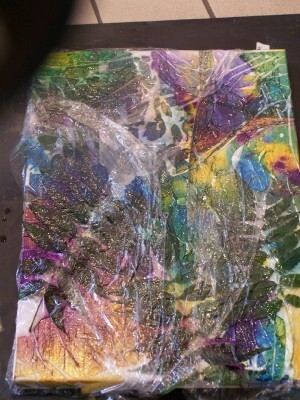PROGRAM SEPTEMBER 2012 - TRISH MCKINNEY
Trish started the program talking about what we should consider before we actually paint a picture. The first two things are inspiration and content or subject. She also stressed that design was an important part of her work. A couple rules of design that she talked about were the rule of 3 or odd numbers and the use of dark against light. One of her favorite design forms is the cruciform similar to a Y design. After this discussion on design she proceeded to show us her technique of paintings leaves.
Trish uses a lot of unusual things to achieve different effects in paintings. Some of the things are saran wrap, wax paper, Halloween cob webbing, inks, fluid acrylics and leaves. Most the time she limits herself to three colors. She either paints on watercolor canvas or 140 lb. hot press.
She starts her painting by putting webbing in a design on her canvas. She then starts to squirt different colors of ink around the canvas and spraying with water to help disburse the ink. Next she takes her leaves and strategically places them around her canvas, creating a design. When creating the design with the leaves you need to consider negative space, focal points, and include a variety of shapes. Also be sure to allow things to run off the page. It’s important to use leaves that are soft and porous so they absorb some of the color. When laying the leaves on the canvas you want to put the vein side down.



After placing the leaves she uses wax paper to create the effect of bark. She does this by crumbling the wax paper and tearing it into small pieces. Then placing it on the paper, she uses a roller to help press the leaves and wax paper into place. Then the last step in this stage of the painting is using the saran wrap over most the painting creating unusual lines and texture. At this point you let the painting dry.



The second stage of this painting is the removal of the wax paper and the saran wrap. With the use of fluid acrylics and a small roller she adds more color to create a design. Trish then decides what she likes about the painting and then uses gesso to tone down or eliminate certain areas she doesn’t like. Next she removes the leaves. Sometimes she repaints or gesso’s the leaves, pressing them back into the canvas with a roller to enhance the design. After that Trish will outline some of the leaves using an oiler boiler that she gets at Cheap Joe’s. She will use fluid acrylics to tint some of the areas that she gessoed. When the painting is dry she sprays it with a glossy Krylon fixative.
Her technique of using unusual items to create different textures and effects will be an inspiration to us all. Hopefully we will be able to use some of these ideas in our future art pieces.




Submitted by Kathy Kuyper
Photos by Deb Ward
Just a few more photos of Trish's process:




